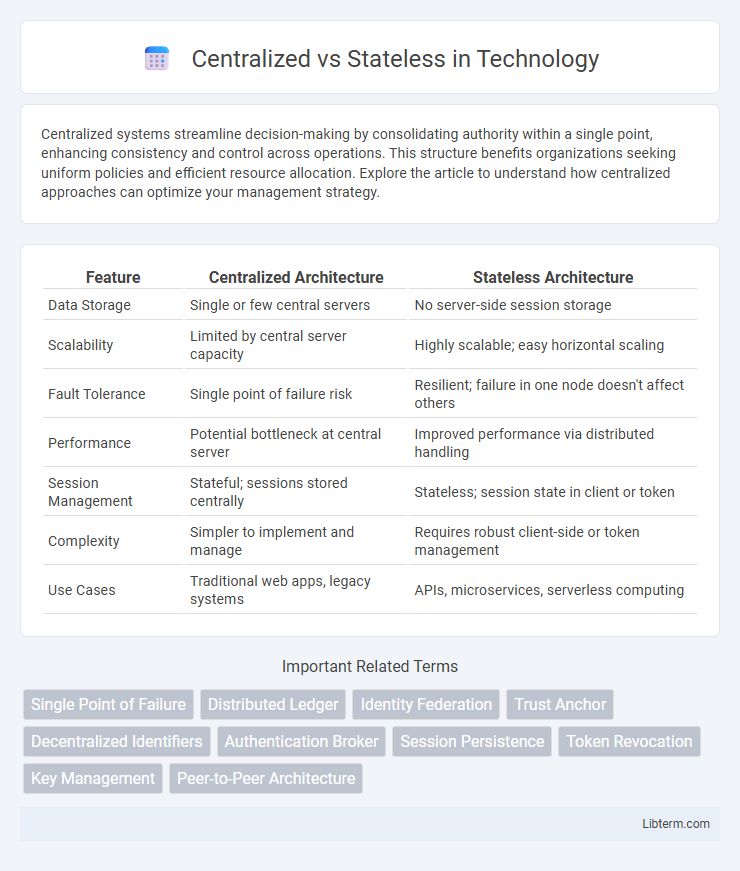Centralized systems streamline decision-making by consolidating authority within a single point, enhancing consistency and control across operations. This structure benefits organizations seeking uniform policies and efficient resource allocation. Explore the article to understand how centralized approaches can optimize your management strategy.
Table of Comparison
| Feature | Centralized Architecture | Stateless Architecture |
|---|---|---|
| Data Storage | Single or few central servers | No server-side session storage |
| Scalability | Limited by central server capacity | Highly scalable; easy horizontal scaling |
| Fault Tolerance | Single point of failure risk | Resilient; failure in one node doesn't affect others |
| Performance | Potential bottleneck at central server | Improved performance via distributed handling |
| Session Management | Stateful; sessions stored centrally | Stateless; session state in client or token |
| Complexity | Simpler to implement and manage | Requires robust client-side or token management |
| Use Cases | Traditional web apps, legacy systems | APIs, microservices, serverless computing |
Introduction to Centralized and Stateless Systems
Centralized systems rely on a single control point where all processing and decision-making occur, ensuring consistent data management and simplified troubleshooting. Stateless systems, by contrast, treat each request independently without relying on stored context or session information, enhancing scalability and fault tolerance. Understanding these fundamental differences is crucial for designing efficient architectures in distributed computing and cloud services.
Key Differences Between Centralized and Stateless Architectures
Centralized architectures rely on a single control point where all data processing and decision-making occur, ensuring consistent state management but creating potential bottlenecks and single points of failure. Stateless architectures, in contrast, treat each request independently without relying on stored context, improving scalability and fault tolerance by distributing workload across multiple nodes. The key difference lies in state management: centralized systems maintain state within a core component, while stateless systems distribute state externally or avoid it altogether, enabling more flexible and resilient designs.
Advantages of Centralized Systems
Centralized systems offer streamlined data management by consolidating information in a single location, enhancing security and simplifying backup processes. They enable consistent policy enforcement and easier maintenance due to centralized control over resources and configurations. Centralized architectures also reduce latency for decision-making by minimizing the need for data synchronization across distributed nodes.
Advantages of Stateless Systems
Stateless systems enhance scalability by eliminating the need to store session information between requests, enabling seamless load balancing and improved fault tolerance. They simplify server design and reduce resource consumption, as each request contains all necessary data, minimizing dependence on centralized storage. This approach ensures better performance in distributed environments and facilitates easier recovery from failures.
Use Cases for Centralized Models
Centralized models excel in use cases requiring consistent real-time data updates, such as financial trading platforms and centralized control systems in manufacturing. They are ideal for scenarios demanding strong data cohesion and centralized governance, like enterprise resource planning (ERP) and customer relationship management (CRM) systems. These models effectively handle tasks where latency sensitivity and unified data access are critical, including smart grid management and centralized security monitoring.
Use Cases for Stateless Models
Stateless models excel in microservices architectures, enabling independent scaling and rapid recovery without session data dependencies, crucial for high-availability applications such as online payment processing and real-time analytics. They enhance cloud-native environments by seamlessly supporting containerized workloads and serverless functions, optimizing resource utilization and reducing latency. This architecture suits event-driven designs and APIs where each request is self-contained, improving fault tolerance and simplifying horizontal scaling.
Scalability: Centralized vs Stateless Approaches
Centralized systems often face scalability limitations due to bottlenecks at a single control point, restricting performance and increase in user load. Stateless architectures enhance scalability by distributing workload evenly across multiple nodes without relying on persistent server-side sessions, enabling easier load balancing and horizontal scaling. This approach reduces dependency on central resources, allowing systems to handle higher traffic volumes with improved fault tolerance and responsiveness.
Security Considerations in Centralized and Stateless Designs
Centralized security models enable stronger control through unified enforcement of authentication, access management, and intrusion detection, minimizing attack surfaces and simplifying compliance. Stateless designs improve scalability and fault tolerance by avoiding server-side session storage but require robust token-based authentication and secure communications to prevent replay attacks and unauthorized access. Ensuring secure stateless architecture depends heavily on cryptographic token integrity, expiration policies, and continuous validation against centralized identity providers or trusted authorities.
Performance Implications of Each Architecture
Centralized architectures often experience bottlenecks due to single points of resource management, which can limit scalability and increase latency under heavy loads. Stateless architectures improve performance by distributing workload evenly across multiple servers, enabling easier scaling and faster response times through load balancing. However, stateless designs may introduce overhead for state synchronization in certain applications, potentially affecting throughput depending on the consistency model used.
Choosing the Right Architecture for Your Application
Choosing the right architecture for your application depends on its scalability, performance, and fault tolerance requirements. Centralized systems offer simplified management and consistency by relying on a single authoritative source, ideal for applications needing strong coordination. Stateless architectures enhance scalability and resilience by treating each request independently, making them suitable for distributed environments and microservices.
Centralized Infographic

 libterm.com
libterm.com